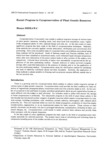Recent Progress in Cryopreservation of Plant Genetic Resources
JIRCAS international symposium series
| ISSN | 13406108 |
|---|---|
| 書誌レコードID(総合目録DB) | AA1100908X |

本文フルテキスト
intlsymp-2_155-167.pdf490.92 KB
Cryopreservation, if successful, may enable to achieve long-term storage of various types of plant genetic resources, including seeds, both short-lived and recalcitrant types, vegetatively propagated plants in vitro, cultured tissues and cells, etc. In the last couple of years, significant progress has been made in the field of cryopreservation techniques. Basically, three methods are currently applied, namely desiccation, vitrification and conventional slow prefreezing. Here some successful cases of cryopreservation and problems encountered using these methods will be introduced. Seeds of Eutrema wasabi and Poncirus trifoliata, both of which have been classified as recalcitrant seeds, could withstand liquid nitrogen temperature either after slow desiccation of the entire mature seeds or after excision of the embryo axis, respectively. Cultured shoot primordia of melon were successfully cryopreserved by the application of the slow prefreezing method. Somatic embryos of melon survived cryogenic storage after controlled desiccation in the presence of abscisic acid or by the application of the slow prefreezing method. Cryopreservation using the vitrification method for meristems and buds of relatively cold-hardy plants has been successful. However, the application of these methods to plants sensitive to freezing such as potatoes remains difficult, mainly due to the low survival rate.
| 作成者 | Masaya ISHIKAWA |
|---|---|
| 公開者 | Japan International Research Center for Agricultural Sciences |
| オンライン掲載日 | |
| 号 | 2 |
| 開始ページ | 155 |
| 終了ページ | 167 |
| 言語 | eng |
